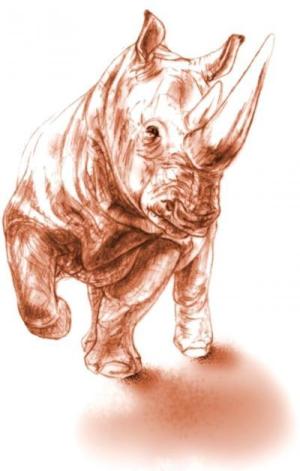Less than 2% of Earth’s fossils are preserved in volcanic rock, but researchers have identified a new one: the skull of a rhino that perished in a volcanic eruption 9.2 million years ago.
The find is described in a paper published Nov. 21 in the open access journal PLOS ONE by Pierre-Olivier Antoine and colleagues from the University of Montpellier, France.

The fossil, found in Turkey, is thought to be that of a large two-horned rhino common in the Eastern Mediterranean region during that period. (Credit: Reconstruction by Maëva J. Orliac; Antoine et al. (2012) A Rhinocerotid Skull Cooked-to-Death in a 9.2 Ma-Old Ignimbrite Flow of Turkey. PLoS ONE doi:10.1371/journal.pone.0049997)
The fossil, found in Turkey, is thought to be that of a large two-horned rhino common in the Eastern Mediterranean region during that period. According to the researchers, unusual features of the preserved skull suggest that the animal was ‘cooked to death’ at temperatures that may have approached 500° C, in a volcanic flow similar to that of the eruption of Mt. Vesuvius in Italy in 79 A.D.
The rhino’s grisly death was near-instantaneous, and followed by severe dehydration in the extreme heat of the eruption. As the researchers describe its end, “the body was baked under a temperature approximating 400°C, then dismembered within the pyroclastic flow, and the skull separated from body.” The flow of volcanic ash then moved the skull about 30 km north of the eruption site, where it was discovered by the four member research team.
Although other researchers have previously identified fossils of soft-bodied organisms preserved in volcanic ash, organic matter near an active volcanic eruption is usually quickly destroyed by the high temperatures, making a fossil such as this one extremely rare.



 November 22nd, 2012
November 22nd, 2012  Riffin
Riffin  Posted in
Posted in 